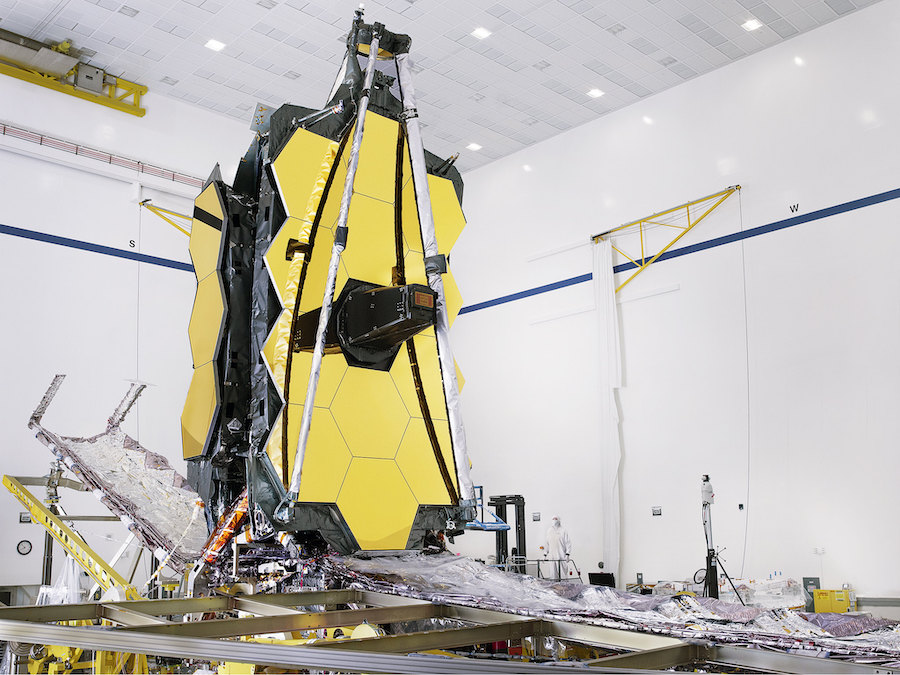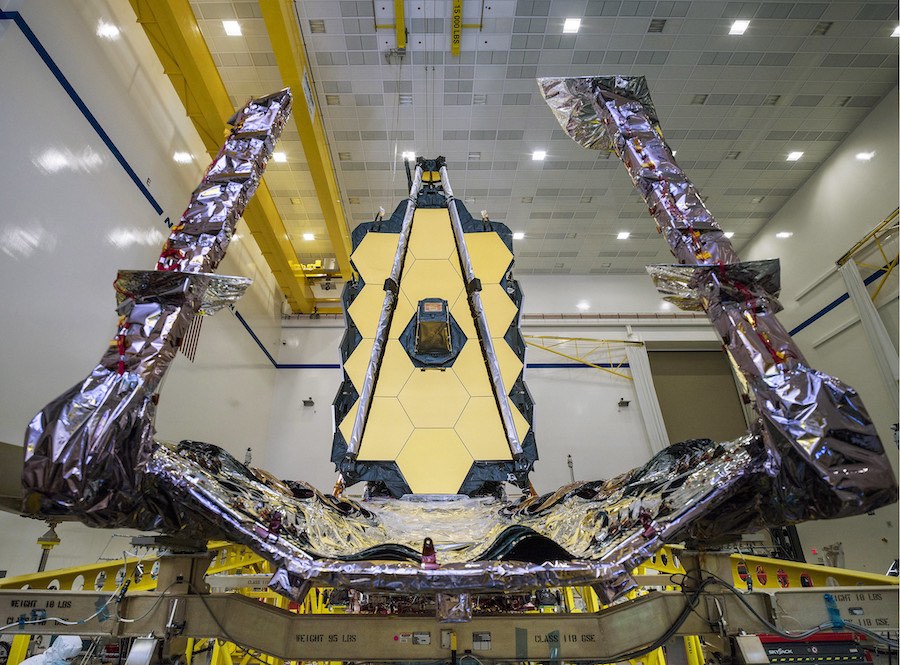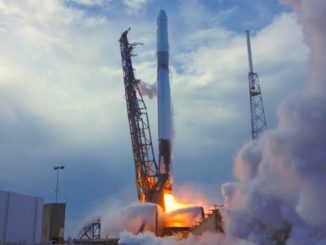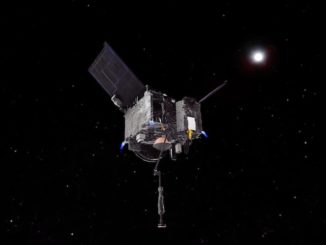
Teams working in Northrop Grumman’s spacecraft factory in Southern California have connected the spacecraft and science modules of the James Webb Space Telescope for the first time, a major milestone as engineers prepare to verify a fix to tears in the observatory’s sunshield, and begin launch vibration and acoustic testing in the coming months.
Technicians at Northrop Grumman’s facility in Redondo Beach, California, mated JWST’s telescope with its spacecraft bus Aug. 23. Since then, workers have been finalizing mechanical and electrical connections between the two main elements of the observatory, the most capable space telescope ever built.
“This is a huge milestone for us,” said Eric Smith, JWST’s program scientist at NASA Headquarters in Washington. “This is a program that was first kind of in people’s minds about 30 years ago. Some of the initial contracts went out in 2001 and 2002, and to see it in that clean room now is breathtaking. A lot of people have waited a long time for this. It’s wonderful to see.”
Set for launch from French Guiana aboard a European Ariane 5 rocket in March 2021, the James Webb Space Telescope will cost more than $10 billion by the time its mission is complete, including contributions from NASA, the European Space Agency and the Canadian Space Agency.
NASA is bearing the bulk of the cost at around $9.7 billion. ESA is providing instrument hardware and a launch vehicle for Webb, and Canada built the fine guidance sensor and a spectrograph for the observatory.
“This is an exciting time to now see all Webb’s parts finally joined together into a single observatory for the very first time,” said Gregory Robinson, the Webb program director at NASA Headquarters. “The engineering team has accomplished a huge step forward and soon we will be able to see incredible new views of our amazing universe.”
Webb’s spacecraft and science modules have been individually tested at various steps of assembly over the past decade. Now it’s time to test the entire observatory in one piece.
A crane lifted Webb’s telescope element over the spacecraft bus and sunshield, and carefully lowered it into place. There are six mechanical attach points between the science module, which includes Webb’s telescope and science instruments, and the spacecraft bus, plus around a dozen wiring harnesses, each routing numerous data and electrical cables, Smith said
Once teams complete the connections, they will unfurl the observatory’s tennis court-sized sunshield, a thermal barrier designed to keep Webb’s sensitive infrared detectors cold.
Made of five Kapton membranes, each as thin as a human hair, the sunshield is designed to deploy to its open configuration once Webb is in space. The membranes are coated with aluminum and treated silicon to reflect heat away from the observatory, keeping Webb’s instruments as cold as minus 370 degrees Fahrenheit, or minus 223 degrees Celsius. Internal coolers will chill some of the telescopes’s sensors even colder.
Engineers found seven tears on the sunshield membranes during a previous deployment test, and a tensioning system used to hold the membrane into its shape developed too much slack during the test, creating a snagging hazard, NASA said.
Since discovering and repairing the sunshield tears, ground teams put the spacecraft element, which holds the sunshield, through a series of vibration, acoustic and thermal vacuum tests to expose the hardware to the shaky, noisy, cold, airless environments it encounter during launch and in space.
“They will now deploy the sunshield to make sure that it behaves as expected after going through the launch (environments),” Smith said Wednesday. “They’ll release all the membrane devices and push out the booms for the sunshield, and tension up the membranes.
“That’s one of the things they certainly will be looking for, is having gone through the environments, what’s the shape of the sunshield coming out of those?” Smith said. “Were the procedures that they put in place to correct some of the things that caused some tears last time, did they work as planned? That’s very much a part of this deployment test.
“They also needed to make some adjustments to the so-called membrane tensioning system, the system of pulleys that actually tighten up the sunshield,” Smith said in an interview with Spaceflight Now. “So they made those adjustments, and we’ll be seeing did that do what we needed it to do as well.”
The test crew at Northrop Grumman will also deploy other structures on the telescope, then put the entire observatory through electrical, vibration and acoustic tests. After those checks are complete, technicians will unfurl the full observatory once more to make sure all the mechanisms survived the launch environment testing.
Then technicians will stow the observatory into launch configuration.
The observatory folds up origami-style to fit under the Ariane 5 rocket’s payload shroud. Depending on how you count, Webb will have more than 300 deployments after it separates from from the upper stage of the Ariane 5 launcher. Counting steps in a similar way, the Curiosity Mars rover had around 70 deployments, according to NASA.
Named for James Webb, the NASA administrator from 1961 through 1968, the new observatory will be stationed nearly a million miles (1.5 million kilometers) from Earth, using a 21.3-foot (6.5-meter) mirror and four science instruments to peer into the distant universe, studying the turbulent aftermath of the Big Bang, the formation of galaxies and the environments of planets around other stars.

Smith said NASA has around three months of margin in Webb’s schedule before the mission’s target launch date of March 30, 2021. That extra time could be used to resolve issues that crop up during the remaining ground tests.
“You test this hardware on the ground because if there are issues, you want to find them so you can correct them before you send it up to orbit,” Smith said. “A program as large as Webb has a very extensive testing program, and it’s something we have to go through.
“The number of first-time activities — those things that we’ve never done before, and hence maybe we don’t understand as (fully) as something we’ve already done before — those numbers are getting small now,” he said. “Most of this hardware has been exercised. The vibe (vibration) and acoustics test as one unit, yeah, that’s a first-time activity because we’ve never had it together before. But it’s something we’ll have to do, and that’s why we have schedule margin built in to fix things that go awry, if they do, during testing.”
NASA last year acknowledged Webb would not be ready for its previous target launch date in 2019. That launch delay came after an announcement in 2017 that the mission would not launch in 2018, as previously scheduled.
The launch delay to 2021 came with an extra cost of nearly $1 billion. It was just the latest in a series of budget-busting schedule slips in the program’s tortured history.
An independent review board blamed the the most recent delay and cost growth primarily on mistakes by Webb’s manufacturing and test team at Northrop Grumman. The panel also said NASA was being too optimistic in its schedule predictions.
NASA says engineers have replaced a catalyst bed heater and valves in Webb’s propulsion system damaged by human error.
Workers improperly installed fasteners on Webb’s sunshield before an acoustic test, and a number of screws, washers and nuts came loose during the spacecraft’s acoustic test. After initially failing to account for all of the fasteners — raising concerns some of it fell into the spacecraft — teams have now found all of the hardware, Smith said.
Read more details on the issues that caused Webb’s launch delay to 2021.
Engineers have identified a couple of other problems on the spacecraft bus that require attention, Smith said.
“When we came out of environmental testing on the spacecraft, there were two electronic components that did not work as planned,” he said. “One was a component of a communications system. It’s an amplifier. We have redundant amplifiers, but one of them didn’t work as planned.
“And some boards on one of the command and telemetry processors that (were also behaving in a way that wasn’t expected,” he said. “So we’re buying new amplifiers … and we are taking engineering units of the command and telemetry processors that we already have and sort of upgrading those for flight.”
Workers will replace the amplifier and command and telemetry processor after the sunshield deployment test.
“At the same time we’re replacing this amplifier, we will replace one of these command and telemetry processors,” Smith said. “This is a redundant system, so we’re just replacing one of them.”
“The spacecraft has all of its electronics and avionics on the side panels of it, so there is a period now where we have to basically (lay) one of those panels flat to replace these two things,” Smith said. “So we had to use up some schedule margin to accommodate that change, but that’s factored in, and we still have margin to launch.”
Officials from ESA and Arianespace have also agreed to modify the design of vents on the Ariane 5 rocket’s payload shroud to address a concern that a depressurization event could damage the Webb observatory when the fairing jettisons after liftoff.
The clamshell-like fairing will protect Webb as the Ariane 5 rockets through the dense lower layers of the atmosphere. Once above the discernible atmosphere, the fairing will release to shed weight as the Ariane 5 climbs into space.
Engineers were concerned residual air trapped in Webb’s folded sunshield membranes could cause an “over-stress condition” at the time of fairing separation.
Smith said NASA provide Arianespace, the Ariane 5’s launch operator, with high-fidelity sensors to fly on two Ariane 5 missions and measure the pressure inside the fairing during the shroud separation sequence.
“They show that there is an issue with depressurization, meaning that there would be enough residual pressure that it could threaten some of our hardware,” Smith said. “So they have agreed that to resolve this, what they’re going to do is install some additional hardware on their vents. These shrouds have vents around the base of them, and we believe the issue was that while they open on the way up, just because they’re vibrating around, they may not stay full open the whole way.
“So ESA and Ariane are working on a design that will essentially keep these vents open once they open up, and all the calculations show that that should make the pressure fall below where we need it to for our payload,” Smith said. “So that story is coming to a good resolution.”
The new hardware to keep the fairing vents latched open will fly on an Ariane 5 mission before Webb to verify the change works.
Email the author.
Follow Stephen Clark on Twitter: @StephenClark1.



